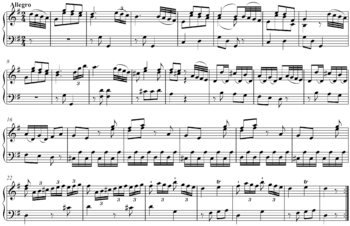Exposition (music)
In musical form and analysis, exposition is the initial presentation of the thematic material of a musical composition, movement, or section. The use of the term generally implies that the material will be developed or varied.
- In sonata form, the exposition is "the very first major section, incorporating at least one important modulation to the dominant or other secondary key and presenting the principal thematic material."[2]
- In a fugue, the exposition is "the statement of the subject in imitation by the several voices; especially the first such statement, with which the fugue begins."[3]
Exposition in classical sonata form
The term is most widely used[4] as an analytical convenience to denote a portion of a movement identified as an example of classical tonal sonata form. The exposition typically establishes the music's tonic key, and then modulates to, and ends in, the dominant.[5] If the exposition starts in a minor key, it typically modulates to the relative major key, or less commonly, the minor dominant. There are many exceptions—for example the exposition of the first movement of Beethoven's Waldstein Sonata modulates from C major to the mediant E major. The exposition may include identifiable musical themes (whether melodic, rhythmic or chordal in character), and may develop them, but it is usually the key relationships and the sense of "arrival" at the dominant that is used by analysts in identifying the exposition. The exposition in classical symphonies is typically repeated, although there are many examples where the composer does not specify such a repeat.
If the movement starts with an introductory section, this introduction is not usually analysed as being part of the movement's exposition.
In many works of the Classical period and some of the Romantic era, the exposition is often bracketed by repeat signs, indicating that it is to be played twice. This is something which is not always done in concert from the 20th Century onwards.[6]
Exposition in fugue form
A fugue usually has two main sections: the exposition and the body. In the exposition, each voice plays its own adaptation of the theme, in either a subject or an answer; they also provide countersubjects (counterpoints) to the following voices as they enter.[7] The exposition usually ends on either a I or V chord, and is then followed by the body.[8]
References
- ↑ Benward & Saker (2009). Music in Theory and Practice: Volume II, p.136-38. ISBN 978-0-07-310188-0.
- ↑ Don Michael Randel (2003). The Harvard Dictionary of Music. Harvard University Press. ISBN 978-0-674-01163-2.
- ↑ Don Michael Randel (2003). "Exposition" Harvard Dictionary of Music,p.302 ISBN 0-674--01163-5 Retrieved from https://books.google.com/books?id=02rFSecPhEsC&printsec=frontcover&dq=%22harvard+dictionary+of+music%22&hl=en&ei=0fGpTKb_GcSclgfms6XZDA&sa=X&oi=book_result&ct=result&resnum=1&ved=0CC8Q6AEwAA#v=onepage&q&f=false
- ↑ William E. Grim, "The Musicalization of Prose: Prolegomena to the Experience of Literature in Musical Form" Papers presented at the Second World Phenomenology Congress September 12 — 18, 1995, Guadalajara, Mexico, in Analecta Husserliana: The Yearbook of Phenomenological Research LXIII (1998): 65. "The first section of a sonata form is called the exposition."
- ↑ William E. Grim, "The Musicalization of Prose: Prolegomena to the Experience of Literature in Musical Form" Papers presented at the Second World Phenomenology Congress September 12 — 18, 1995, Guadalajara, Mexico, in Analecta Husserliana: The Yearbook of Phenomenological Research LXIII (1998): 65. "It is in this section that there is harmonic movement away from the primary tonal area to the secondary tonal area."
- ↑ Charles Michael Carroll, "Memories of Dohnányi" Perspectives on Ernst von Dohnányi, edited by James A. Grymes. Lanham, Maryland: The Scarecrow Press, Inc. (2005): 235
- ↑ Alfred Blatter, Revisiting Music Theory: a Guide to the Practice, New York: Routledge, (2007): p.249-250 ISBN 0-415-97440-2 https://books.google.com/books?id=Z-xfT0jMc9oC&printsec=frontcover&dq=Revisiting+music+theory:+a+guide+to+the+practice&source=bl&ots=2XdInWKF8J&sig=uz7xRfFCraKvukB3H3pfKY_oFzk&hl=en&ei=L_upTLqDCIOClAfx6fCvDA&sa=X&oi=book_result&ct=result&resnum=2&ved=0CB8Q6AEwAQ#v=onepage&q&f=false
- ↑ Alfred Blatter, Revisiting Music Theory: a Guide to the Practice, New York: Routledge, (2007): p.250 ISBN 0-415-97440-2 https://books.google.com/books?id=Z-xfT0jMc9oC&printsec=frontcover&dq=Revisiting+music+theory:+a+guide+to+the+practice&source=bl&ots=2XdInWKF8J&sig=uz7xRfFCraKvukB3H3pfKY_oFzk&hl=en&ei=L_upTLqDCIOClAfx6fCvDA&sa=X&oi=book_result&ct=result&resnum=2&ved=0CB8Q6AEwAQ#v=onepage&q&f=false
